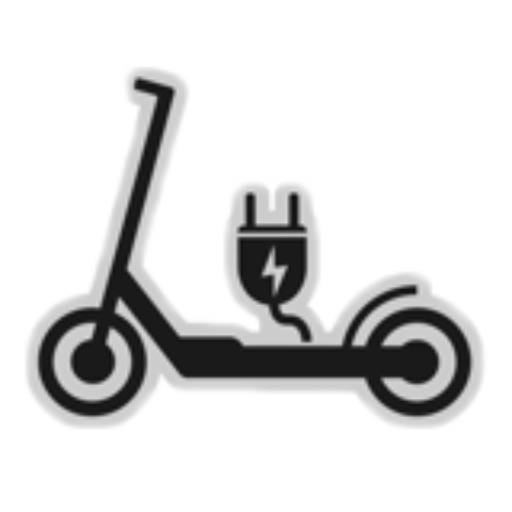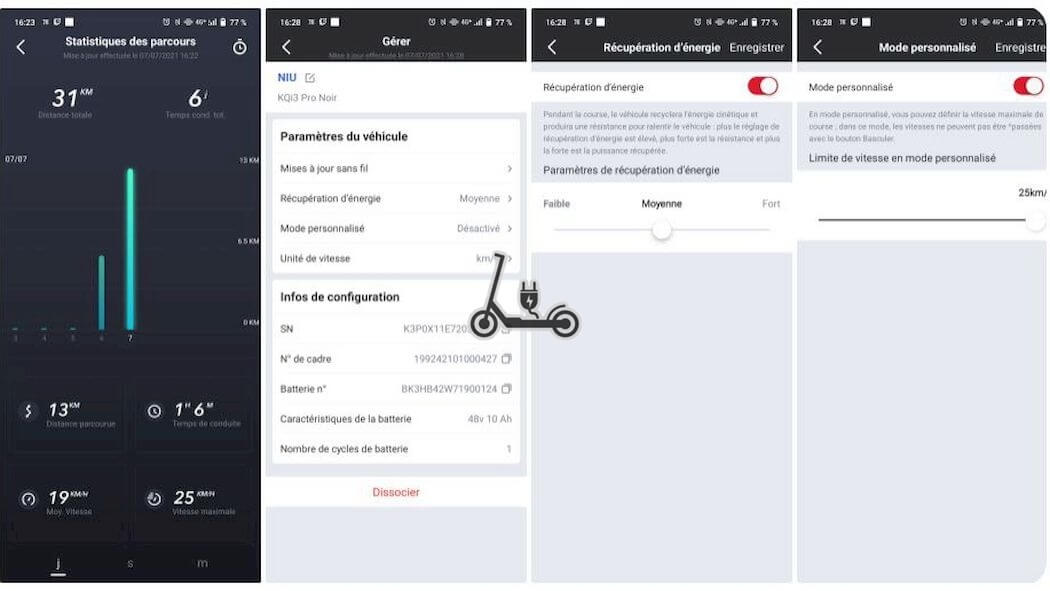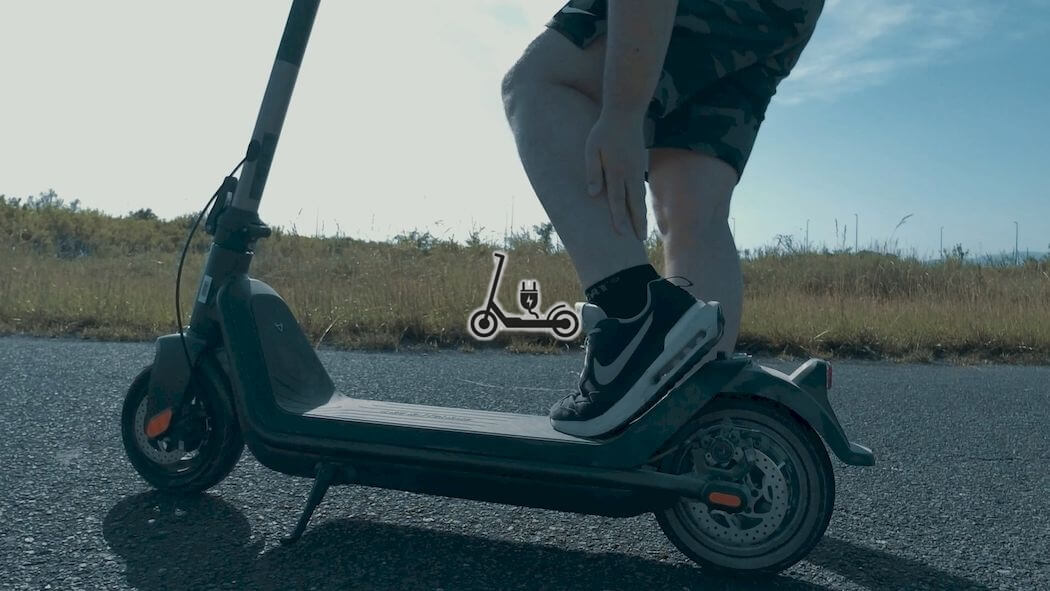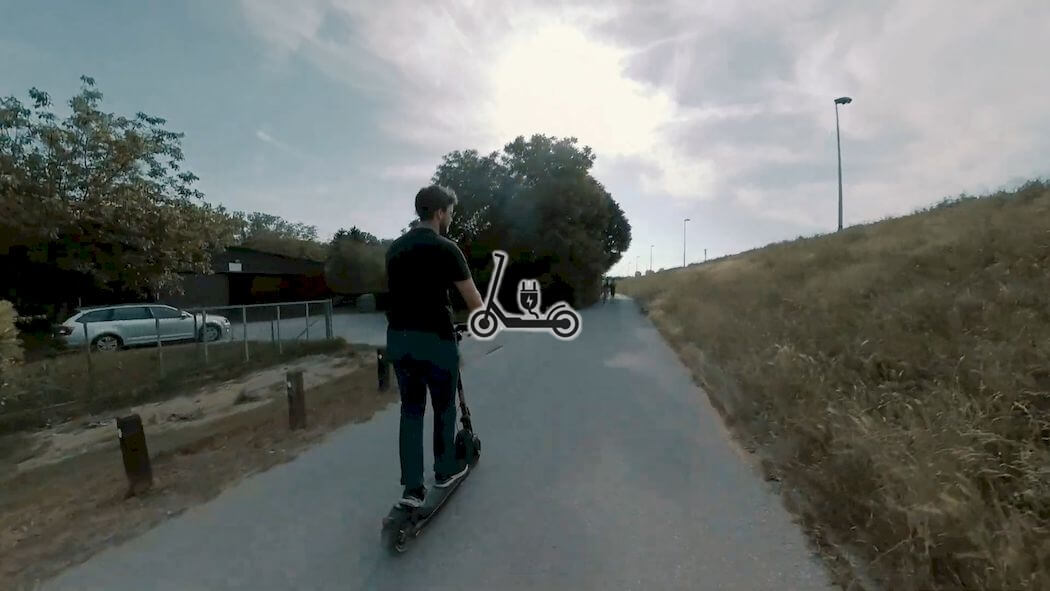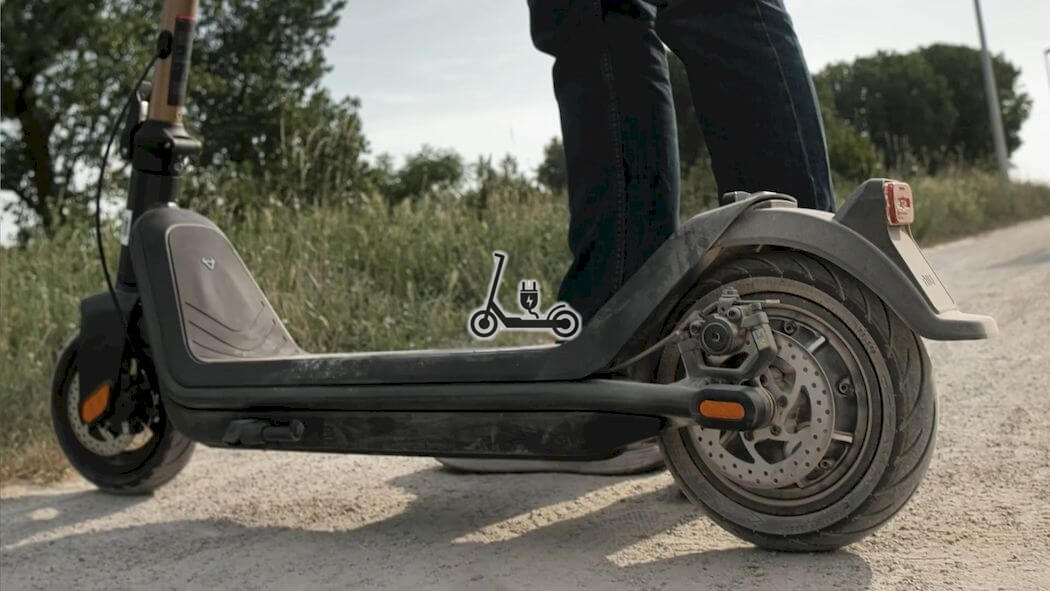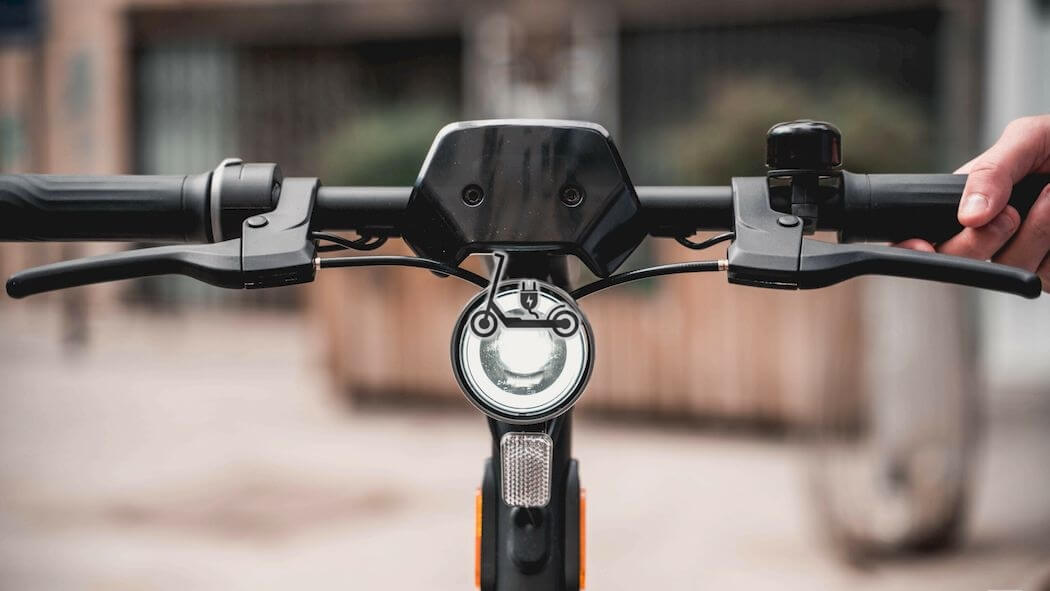Specialist in electric scooters, NIU embarks on the adventure of trendy scooters with a very first model called KQi3.
Niu Technologies, also known as NIU, is a Chinese company founded in 2014 that quickly caught on with investors — raising $125 million across multiple investment rounds. In China and Europe, the brand is best known for its electric scooters.
NIU has a catalog of around ten trendy two-wheelers but is also eyeing the micro-mobility market through electric scooters. This is why the group launched its very first model on Indiegogo on July 13, 2021: the NIU KQi3, available in Sport and Pro versions.
We tested for more than a week during the Pro version. What does it have in the belly at the price of $699? Here is our opinion.
| Make | NIU |
| Model | KQi3 Pro |
| Weight | 20 kg |
| Folded dimensions | 117 by 53 by 53 cm |
| Motor power, continuous | 350 W |
| Top speed | 32 kmh |
| Range | 50 km |
| Battery capacity | 486 Wh |
| Battery recharge time | 6 hrs |
| Max rider weight | 100 kg |
| Brake type | Disc + Disc |
| Tire type | 24.1 cm Pneumatic (Tubeless) + Pneumatic (Tubeless) |
| Built-in lights | Front + Rear |
| Water resistance | IP54 |
NIU KQi3 Pro: Design
The NIU KQi3 Pro has the merit of appealing at first sight. What’s the reason? Its size. And more precisely its a large deck with a width of 17.5 cm and a length of 50 centimeters (flat part included, curved parts excluded). Far from the compact format, the NIU KQi3 is massive, the NIU KQi3 is clumsy. It is difficult to miss it as it imposes itself, for better or for worse.
Let’s start with the best: this electric scooter has the merit of giving you the choice to position your feet. Thanks to its large deck, you can place them perpendicularly – as on many models – but also side by side without your ripatons protruding from the edges – I wear a 41 and a half. What is pleasant is that we do not think where to put our feet: there will always be room to welcome them.
In fact, the NIU KQi3 Pro makes me want to give it the title of “SUV of electric scooters“, a bit like the Canyon Precede: ON on a bicycle scale. Its muscular size and its robust appearance bring a certain feeling of security once at the controls of the machine, which tends to reassure you. For stressed people like me on the handlebars of a scooter, this is a good point.
More concretely, the NIU KQi3 measures 1173 x 1202 x 541.5 mm when unfolded, and drops to 1173 x 504 x 541.5 mm when folded. You will have understood this with regard to the changes observed: only the height changes. To do this, a two-step folding system has been installed at the base of the steering column, to fold it down and the handlebars.
A small hook at the back of the scooter then allows you to fix everything. Simple and efficient. Alas, the handles are neither foldable nor foldable. It is always less practical to store your model in a car trunk for example, or in a bar terrace when your machine is placed on the ground. It is important to point this out.
Also be aware that it is impossible to adjust the height of the handlebars. The NIU KQi3 therefore does not seek to adapt to the maximum number of users, as the E-Twow Booster S+ Premium 2020 could do. From the height of my seventy-six meter, I found the height adapted to my size.
More generally, the NIU KQi3 Pro benefits from a sleek style that is relatively pleasing to the eye. Admittedly, the unsightly welds between the deck and the stem, but also on the rear chainstays, could have been avoided (especially at $699). But on the whole, the result remains more than correct.
A total of 7 reflectors have been installed to improve your visibility to other road users: one below the headlight, two on the sides of the steering column and two others on each side of the wheels. The lights, on the other hand, benefit from LED technology. The one at the rear lights up when you brake to warn people behind you. Always good to take.
The one at the front takes up the stylistic paw of NIU with a round shape, its trademark. At the rear, the light adopts a more conventional rectangular format. A few brake cables appear here and there, but quickly disappear under the handlebars. Nothing too embarrassing, in short.
Still at the rear, a mudguard protects you from splashes, and cannot be used as a manual brake – we asked ourselves the question for a time, the brand confirmed to us that it was not. The structure also quickly separated from the main deck, revealing internal cables. Nothing reassuring. On the other hand, we were assured that the transport of the vehicle was the cause: a more solid packaging should be used for the next deliveries.
For its part, the handlebar hosts in its center a beautiful screen on which we will focus in the rest of this test. The brake handles are placed at a good distance: with my small hands, I never had a problem grabbing them and braking. Same song on the side of the mechanical bell, fixed on the left of the handlebars.
NIU has an eye for detail and even installed a kind of small front visor to provide protection to the screen. I still doubt its usefulness, but why not. The handles finally benefit from slight bumpy lines and a rather soft coating that make the grip very pleasant.
The big downside of the NIU KQi3 Pro remains its weight: 20 kilos. It is heavier than some electric bikes, but also and especially other competitors. For example, the Xiaomi Mi Scooter Pro 2 sold for 500 euros weighs 14.5 kilos, while the E-Twow Booster S+ Premium 2020 drops to 10.9 kilos.
Fortunately, the two-wheeler enjoys good balance and does not tend to tip back and forth due to any excess weight. This allows it to be carried at arm’s length by taking it well in the middle of the steering column. Nevertheless, 20 kilos, it weighs: I therefore advise you to have a lift at home and at work to transport it easily. For the train or the metro, the matter is complicated.
Finally, note that the NIU KQi3 is capable of supporting a user of 100 kilos maximum, and that an IP54 certification protects it from dust deposits and water splashes. It is therefore not suitable for severe weather and too deep puddles. A small kickstand also keeps it straight once the scooter is “parked”.
NIU KQi3 Pro: Application and Screen
The screen of the NIU KQi3 is located in the middle of the handlebars and benefits from a beautiful surface which is unfortunately not exploited enough. Indeed, only the speed and the Bluetooth connectivity are displayed. Autonomy is represented by five round icons, which disappear over the kilometers traveled.
With such a size, this slab could have largely indicated more information, such as the exact remaining autonomy in digital figures, the time or even the mileage. NIU preferred to play the minimalism card and did not want to flood its screen with elements to facilitate its visibility and understanding. It is his choice, but a questionable choice in our eyes.
Visibility, precisely, was not good: in direct sunlight, I happened to squint several times to distinguish my speed of the moment. However, NIU assured us that it would improve the brightness on the final version to distinguish the information displayed.
Also, this screen does not offer a huge margin of maneuver in terms of interactivity. The system is certainly very simple to understand and use, but relatively limited.
A single button is used to manage all the configurations: turn the screen off and on, activate a “full headlight” mode, switch from km/h to mph, switch to on mode (five presses), configure the E-SAVE mode (limited to 15 km/h), and that’s it. It is impossible, for example, to configure the other driving modes directly from the screen. When Xiaomi scooters allow it.
To do this, it is necessary to go through the NIU mobile application, which is also not without constraint: when creating your NIU account and when pairing your phone with the scooter in Bluetooth, a video tutorial is imposed on you. In short, why not. This can be a good booster shot.
Then, it is necessary to travel 500 meters at a maximum of 15 km/h to unlock the sport mode and the 25 km/h. Beyond the frustration generated, the usefulness of this process is to be proven. But again, why not. Be careful though: remember to imperatively update your scooter from the first ignition.
Without this update, you will be constantly stuck at 15 km/h despite the tutorial viewed and the first 500 meters traveled at 15 km/h. I had the bitter experience of it. What’s the solution? Unpair your phone, pair it again, launch the update… then redo the tutorial and the 500 meters at 15 km/h. After that, the scooter finally lets go of the horses.
For its part, the mobile application has the merit of being easy to handle and understand. At the top, the main interface shows your range and remaining battery percentage. A “ Lock ” button allows you to lock the electric scooter when it is on. At the bottom, two tiles on “ Driving Reports ” and “ Ride Statistics ” overlap.
At the bottom, in the center, a “Go” button directs you to a map, which overlooks a speedometer, the battery level, the remaining autonomy, your mileage, the driving time, the average speed or even the elevation and slope. So much information that will appear along your route.
At the very bottom, on the right, a “Me” option gives you access to the profile of the scooter, from which you can manage the updates, the degree of energy recovery (low, medium and high), the personalized mode (allows you to limit your speed to the nearest km/h) and the speed unit (km/h or mph) displayed.
Overall, the software experience is simple and effective. NIU does not get lost in a maze of settings and sub-settings, and does not overdo it in the image of its screen. On the other hand, some errors nestle in the driving reports. Each report indicates the travel times, which are wrong here.
For a trip between my home and my place of work made between approximately 1:20 p.m. and 1:40 p.m., the application expects a 12:12 a.m. – 12:41 a.m. One, the time of my departure is not good. And two, NIU considers us in the middle of the night, not in the middle of the day.
Also, during the update and the tutorial, I noticed some spelling mistakes and texts not translated into French. It’s just an update story.
All this summary is all well and good when reading it: because the connectivity still needs to work between your mobile application and the electric scooter. Alas, it has most of the time buggy. It was enough to let the scooter sleep peacefully overnight, for the pairing between my mobile device and the vehicle to fail.
To overcome this problem, I had to uninstall the application, reinstall it… and this as soon as the problem arose again. What a frustration not to be able to consult its exact autonomy, or even to change the intensity of the regenerative braking. Luckily, NIU assured us that this pre-release build was going to be patched for the official release.
NIU KQi3 Pro: Motor and Power
Let’s make it clear from the start: the NIU KQi3 is a powerful and responsive electric scooter, despite its size and its weight of 20 kilos. A great surprise. With its 350W motor built in-house, the machine has excellent acceleration and responsive pick-up that allows you to pass slower cyclists than you with ease.
In short, it is a great ally in town. On intermediate hills, your speedometer remains stuck at 25 km/h. It therefore has no difficulty in climbing positive elevations, nor in braving strong gusts of headwind.
The small throttle lever is easily manipulated to control its pace at a lower level. And if you don’t want to reach 25 km/h, you can always use the application to curb your two-wheeler.
The NIU KQi3 also manages to weave its way between cars. Admittedly, other more compact scooters do better than it, but on several occasions I have crossed a narrow stretch of road in the middle of cars without this giving me a problem.
NIU KQi3 Pro: Balance and Comfort
Inevitably, without any suspension, driving comfort takes a hit. Certainly, its large wheels absorb a minimum of the roughness of the road, but the weight of the model also counterbalances everything. In short: you will feel your whole body vibrate when rolling on cobblestones. Even small irregularities in the pavement are not pleasant.
Nevertheless, due to its size and large deck, the NIU KQi3 Pro remains pleasant to use once standing on it. However, pay attention to balance: I advise you not to adjust your glasses, put your cap back on or scratch your nose by removing one hand from the handlebars, at the risk of feeling unbalanced. The steering column has a tendency to shake.
NIU KQi3 Pro: Brakes
With front and rear disc brakes, the NIU KQi3 Pro offers you excellent braking phases. The left lever is connected to the rear brake: you might think that it is not biting enough at first, but it is in fact progressive and effective in urgent situations. He actually saved me on several occasions, without systematically blocking the wheel.
The one at the front is almost too biting: I advise you to use it with extreme caution to avoid any “sun”. Nevertheless, it is better to be well equipped with brakes than not enough: in cities, or in dense areas, having good brakes is perhaps one of the elements, if not the element, the more important to ensure your safety.
Problem: a new anomaly that appeared after ten days broke the mood. The rear brake simply let go and the cable no longer exerted any resistance when pressing the lever.
During my test, another unpleasant surprise gradually appeared: phantom braking, exclusively during the regenerative braking phase. Personally, I preferred to use the so-called medium regenerative braking, which seems to me to be a good compromise for stopping at a red light without braking and rushing too much.
On this point, the system made no false note. But for some reason, powerful phantom braking occurred several times during my experience. When stopping to accelerate, and as the regenerative braking kicks in, the electric scooter suddenly brakes for half a second.
This defect is confusing, surprising and dangerous at the same time. I counted about 7 of them over about fifty kilometers covered. It is imperative that NIU corrects this anomaly at the risk of attracting the ire of its users.
NIU KQi3 Pro: Headlights
Two light intensities are available for the headlight. And the least we can say is that the most powerful illuminates your path. The NIU KGi3 Pro offers extremely powerful lights which, in addition to improving your visibility to other users, perfectly illuminate your field of vision.
It is also possible to adjust the angle of the headlight according to your preference. On this point, this electric scooter is faultless.
NIU KQi3 Pro: Battery
The Pro version of the NIU KGi3 Pro benefits from the longest range in the range: 50 kilometers on paper, thanks to a 486 Wh battery. In practice, this radius of action was almost reached at the end of the test. My journeys have indeed allowed me to travel up to 47.5 kilometers. At the very end, the scooter slightly lost acceleration power. The 25 km / h, they were still relevant.
In fact, the NIU KGi3 Pro therefore offers very good autonomy: over a week of face-to-face work, I had to recharge it only on Thursday to leave the next day. Note that I am 176 centimeters tall and weigh 63 kilos, and my rather gentle and careful driving has surely saved me a few battery percentages.
This generous autonomy is therefore not restrictive, and in a way offsets the 6 hours of recharging required. It’s long. I advise you to plug in your scooter in the morning at the office, or at night at home.
The only small downside that I would like to note concerns the sound alert emitted by the scooter when the battery approaches zero. The machine starts beeping. To beep a lot. Every 10 seconds or so, which becomes very annoying after a while. Again, NIU has a small fix to deploy.
NIU KGi3 Pro: Conclusions
Defective rear brake after 10 days of use, dangerous phantom braking, Bluetooth connectivity (and therefore unusable application) in the cabbage, fragile rear mudguard: the NIU KQi3 Pro accumulates failures, at least in its pre-launch version. At all costs, NIU must correct the situation and deploy patches. Without all these flaws, the final grade would probably have risen to 7 or 8. We will test the scooter again when it comes out to check whether NIU keeps its promises or not.
It’s a shame, because this electric scooter could be excellent without these faults: certainly heavy (20 kilos) by design and size, the machine embodies robustness and safety. With it, it’s the assurance of feeling serene in all circumstances thanks to excellent brakes (when they walk) and an appreciated explosiveness.
Its ultra-bright lights will guide you through the night, when the range of around 50 kilometers offers plenty of room to maneuver around town. Good luck on the other hand to move it at arm’s length, despite a well-balanced weight. The NIU KQi3 Pro could be an excellent ally in an urban environment: it’s up to NIU to prove it to us.
NIU KQi3 Pro: Price and Where to buy cheaper?
The NIU KQi3 Pro is available on Indiegogo at a price of $699 including tax, against $599 for the Sport version. An Early Bird offer in limited availability drops their price to 441 and 391 euros, respectively.
We will not fail to test a final version on the day of its release: this test is potentially brought to evolve according to the correction of the noted defects.
POSITIVE POINTS OF THE NIU KQi3 Pro
- Wide deck
- Excellent brakes (when operating normally)
- Top performance
- Powerful headlights
- Security feeling
- Generous battery life
NEGATIVE POINTS OF THE NIU KQi3 Pro
- Screen poorly operated and not bright enough
- Heavy (20 kg), difficult to transport and puny fenders
- Bluetooth connectivity in cabbage
- Rear brake failed after 10 days
- Disturbing phantom braking
- No suspension
